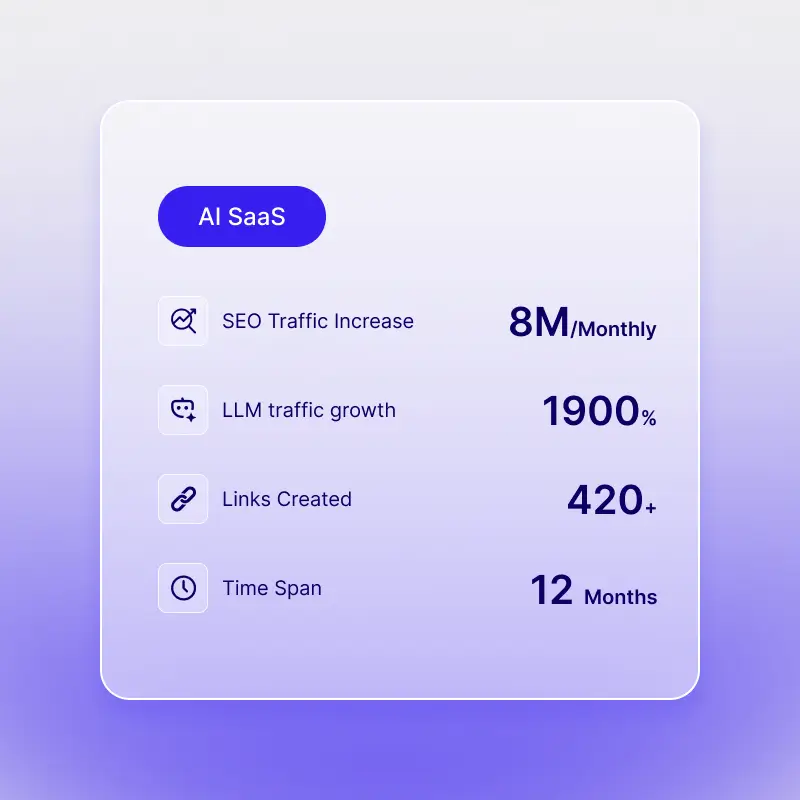
SEO is alive and well. Rank on top of both traditional search engines and AI chatbots.
Over the past two years, our client in the AI niche saw a total of 367.9M website visits from June 2023 to May 2025.
Almost 80% of this traffic—around 293.1M—came from search engines, making SEO their key traffic driving channel.
This growth happened during a time when many believed SEO was dead or that chatbots were taking over.
The client’s monthly SEO traffic grew from 2.5M to 18.5M, a 638.22% increase in just 24 months.
In this case study, we’ll dive into the client’s strategies, the challenges they faced, and how they overcame concerns about AI disrupting SEO.
We’ll also explore how OneLittleWeb supported their journey to achieve these remarkable results.
The goal of this case study is to provide actionable insights for marketers, founders, and SEOs navigating the noise and uncertainty around AI.
We’ll show how focusing on the right SEO and GEO strategies led to a big win, even in the face of rapid changes.
Through a deep analysis of their Google Analytics, Search Console data, and our SEO approach, we’ll highlight what worked—before and after our involvement—and how others can replicate their success.
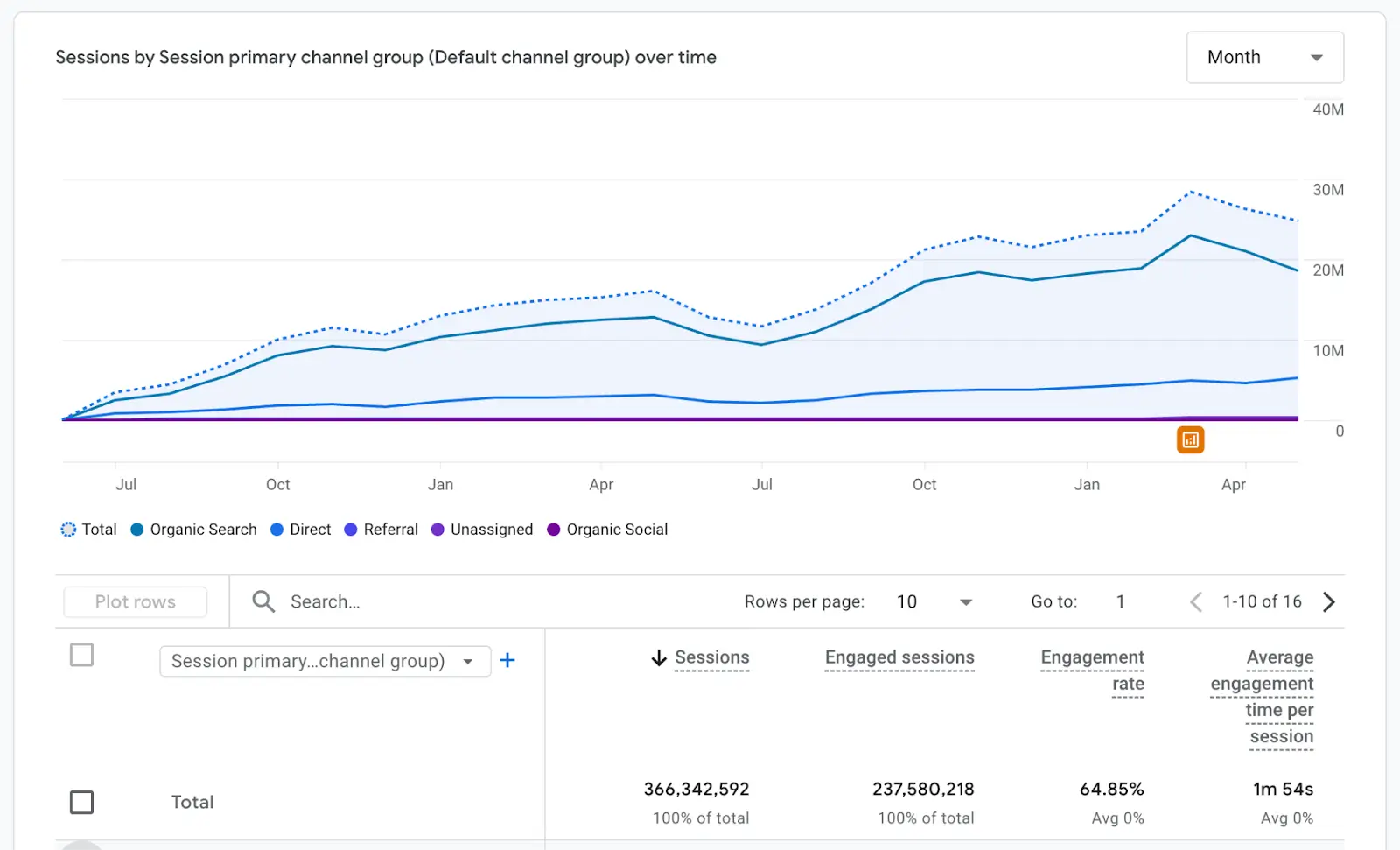
We’ll begin this deep dive by analyzing the total traffic generated during the period from June 2023 to May 2025. Over this time, the client generated a total of 367.9M website visits across all channels.
The website was launched in late 2022, with the primary goal of using SEO as their main traffic driver. Initially, the competition was relatively low, allowing them to rank quickly on top search engines. Their core product positioning was clear from the start, along with just 2–3 key AI tools.
As the product was simple, free, and user-friendly, it quickly gained popularity, attracting natural backlinks and mentions on social media. This helped the website gain traction in the early stages, which led to a growing amount of organic traffic.
The company focused on optimizing Core Web Vitals and ensuring that user intent was met, which further boosted their rankings.
However, by mid-2024, as bigger competitors like OpenAI, Canva, and Character AI began to target the same keywords, the primary keywords that had been ranking #1 for them became highly competitive. As a result, they saw a sharp decline, dropping to 11.7M monthly visits in June and July 2024.
Recognizing that SEO accounted for nearly 80% of their traffic, the client began looking for strategic support. In May 2024, they partnered with OneLittleWeb to help protect and grow their SEO presence.
Later in this case study, we will break down each challenge, explain our approach, and show the results after one year of collaboration.
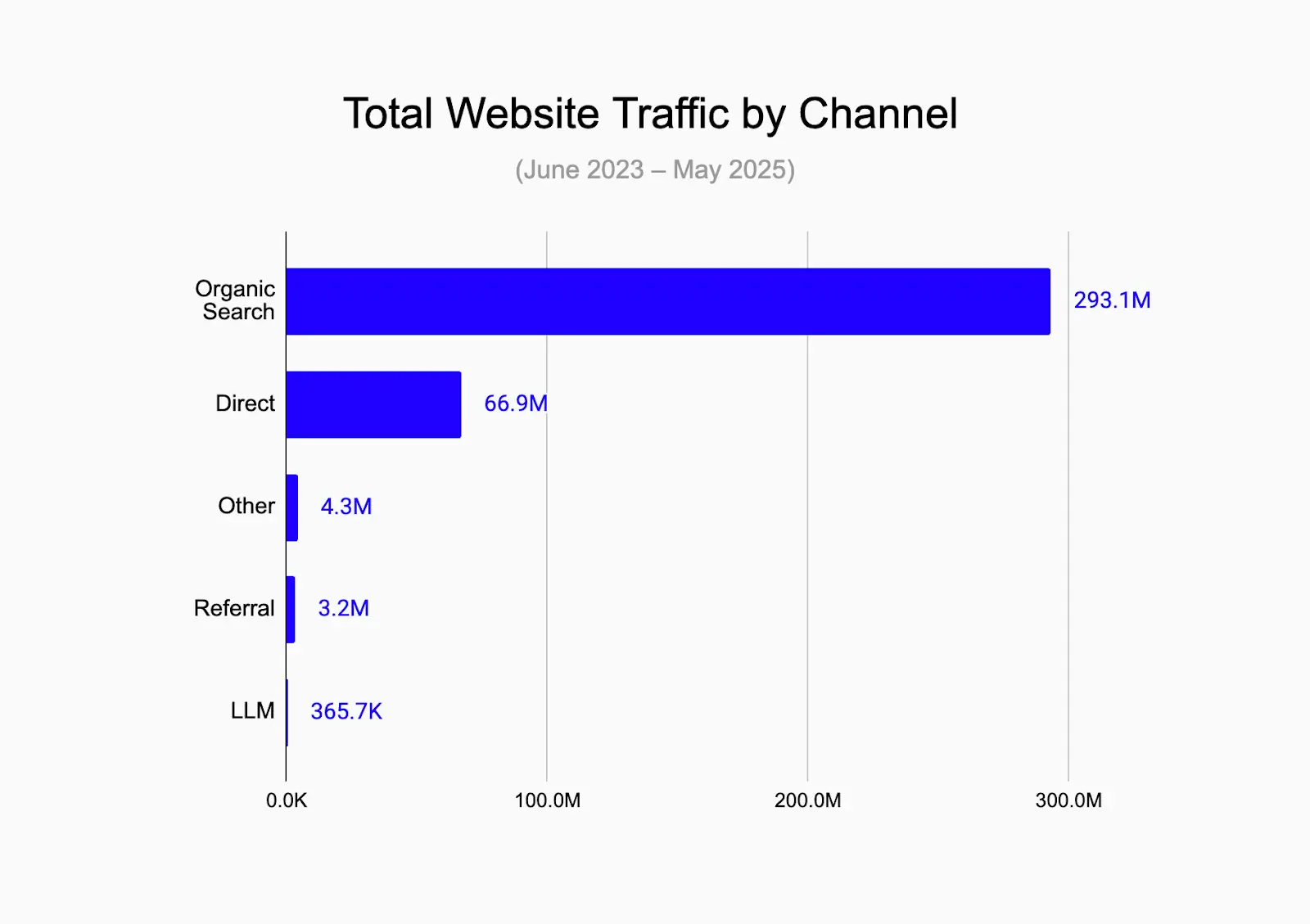
During the 24-month period, the client saw the vast majority of traffic come from organic search—nearly 80% of all visits. This confirms what we’ve seen time and again: SEO continues to be the most consistent and scalable channel for long-term traffic growth.
While AI chatbots and Large Language Models (LLMs) are gaining attention, their traffic contribution was minimal—just 0.1% over the entire period.
Interestingly, most of that LLM-driven traffic came after we implemented Generative Engine Optimization (GEO) strategies, which we’ll explore in detail later.
This doesn’t mean GEO or LLMs should be ignored. On the contrary—businesses need to prepare for the future by making their content accessible to both traditional search engines and generative engines.
But here’s the perspective that matters:
Now isn’t the time to abandon SEO—it’s time to double down on it while layering in GEO to stay ahead.
The focus going forward isn’t “SEO vs GEO.” It’s how to win at both. And that’s exactly what this case study will show—how staying committed to SEO while preparing for LLMs created long-term, cross-channel success.
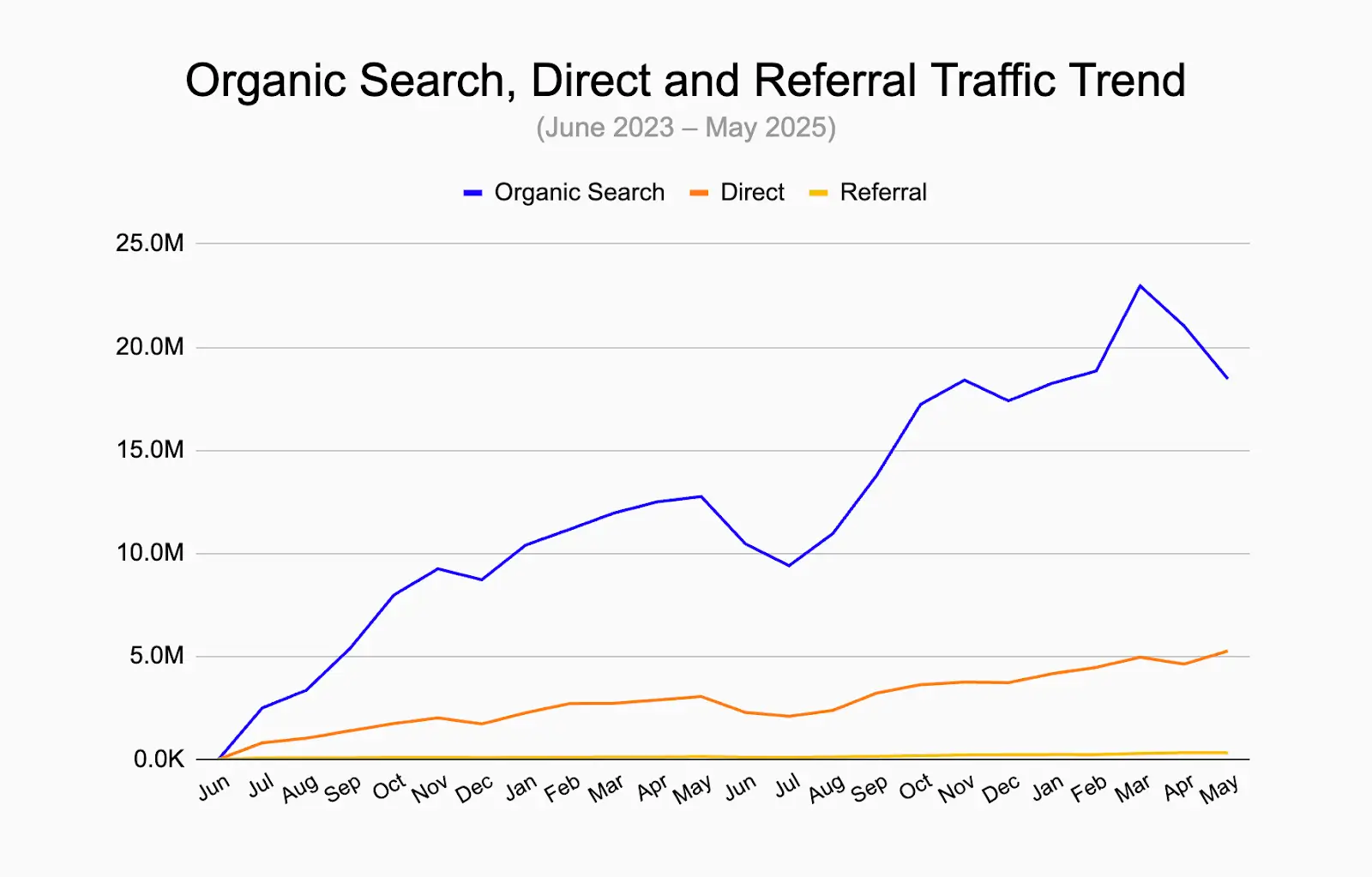
This trend chart shows how traffic evolved over the last 24 months across the top three channels: Organic Search, Direct, and Referral.
The most important takeaway?
Organic traffic didn’t decline—it kept growing.
If SEO were truly on the way out, we’d expect to see stagnation or a drop in organic traffic. Instead, we saw steady and compounding growth.
What’s interesting is how interconnected these channels are. Strong SEO doesn’t just grow organic traffic—it improves discoverability, boosts authority, and drives more brand searches, mentions, and shares.
This observation is backed by a recent Ahrefs study, which found that:
Websites with more organic search traffic tend to get mentioned more in AI search tools like ChatGPT, Perplexity, and others.
That means the better your SEO performance, the more likely you are to show up in AI-driven answers too.
This chart makes it clear:
SEO continues to be a growth engine—not just for organic clicks, but for increasing visibility across all channels, including AI Chatbots.
By the time the client partnered with OneLittleWeb in May 2024, their SEO growth had hit a turning point.
What started as a fast-moving success story was now facing growing pressure—from both outside forces and internal uncertainty. After a full audit of their performance and strategy, we identified three core challenges:
Each of these issues was slowing momentum—and creating confusion about what to prioritize next.
In the following sections, we’ll break down each challenge, share how we approached it, and the impact of our work over the following 12 months.
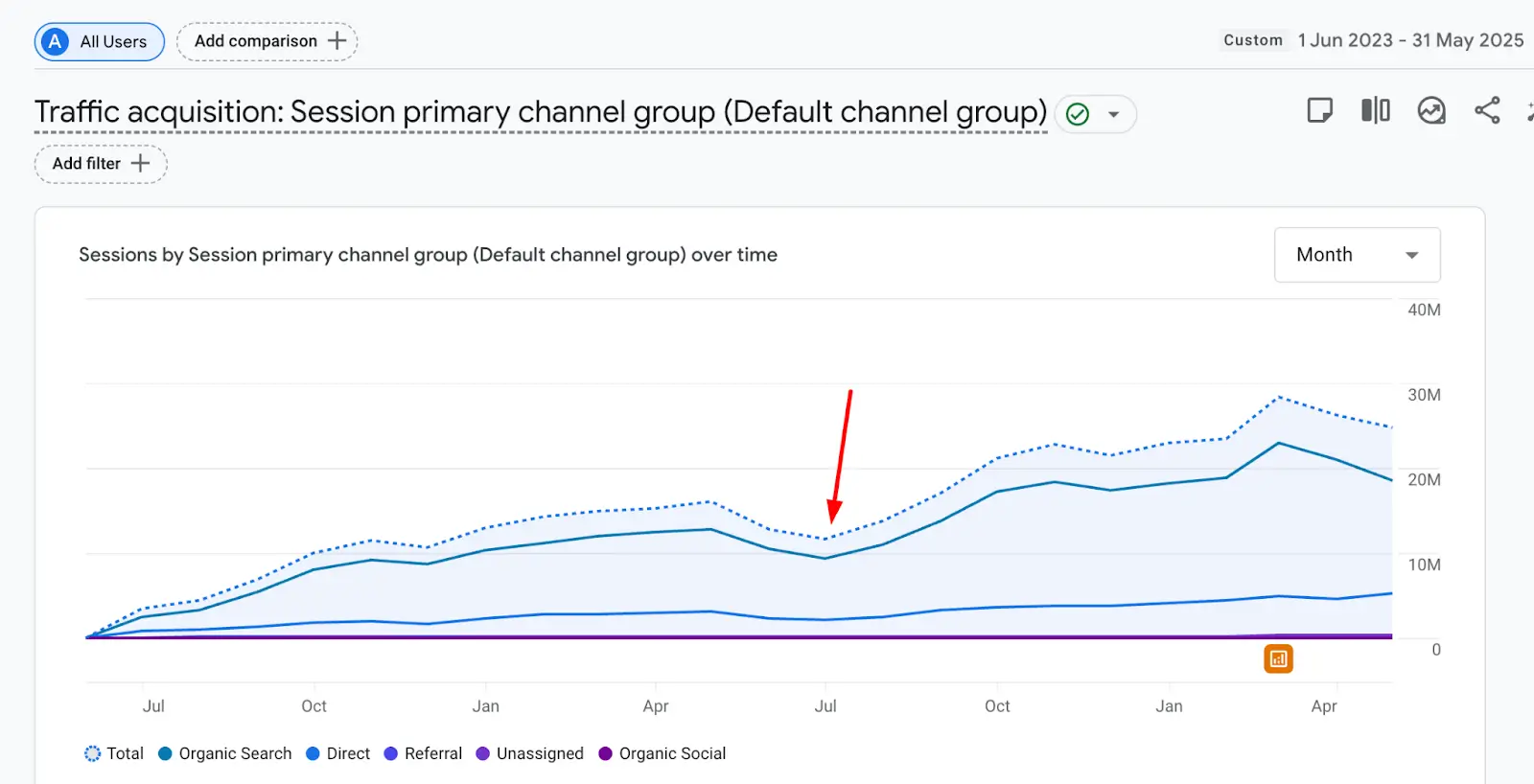
By mid-2024, the client’s traffic—after months of consistent growth—began to drop.
As shown in the chart above, the turning point came around June to July 2024, when total monthly sessions fell from over 16M to around 11.7M. The decline was especially visible in organic search, which had been the main growth driver up until that point.
There was no technical error or penalty involved. The site was still functional, content was live, and the product hadn’t changed. The dip came down to something more strategic:
They were losing rankings for high-traffic keywords they had long dominated.
Traffic loss like this isn’t just a number—it shakes confidence. The team started questioning whether SEO could still be relied on, especially with all the noise around AI taking over search.
This period marked a shift in momentum—and it was one of the first challenges we tackled after joining the project.
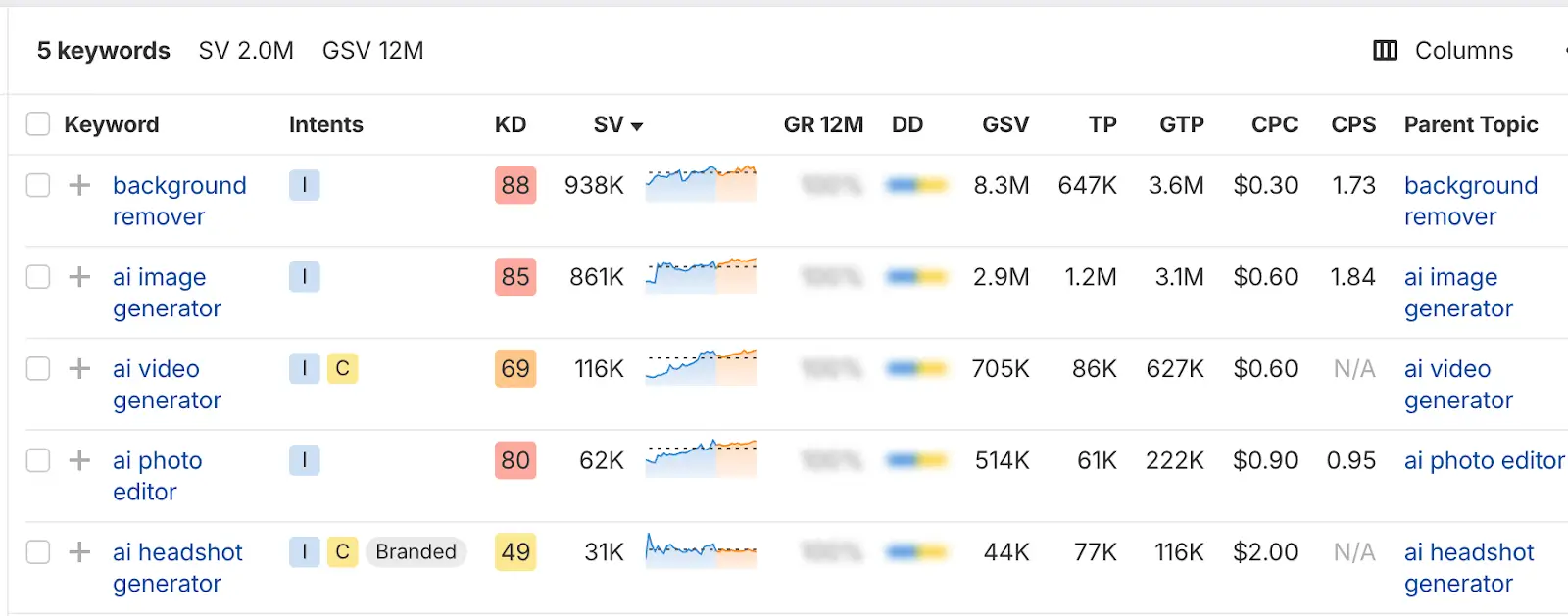
One of the biggest shifts the client experienced was the sudden rise in keyword competition—especially from large, well-established brands entering their space.
At the start, the client ranked for many high-volume terms with relatively low competition. But over time, those same keywords became incredibly competitive.
In the chart above, you can see some of their core terms like:
These now have Keyword Difficulty (KD) scores as high as 88, signaling a saturated SERP landscape.
This shift didn’t happen by accident. Major platforms like OpenAI, Canva, Character AI, and others began targeting the same high-intent keywords. With their massive domain authority, backlink profiles, and content teams, they quickly pushed into top positions.
The client was no longer competing in a niche—they were competing with tech giants.
This level of competition made it harder to defend rankings and maintain traffic. Even minor algorithm updates started having a bigger impact, simply because the SERPs were more volatile and crowded.
At this stage, they didn’t just need content.
They needed precision, defensive SEO, and a strategy built to survive in a high-authority environment.
That’s where we stepped in.
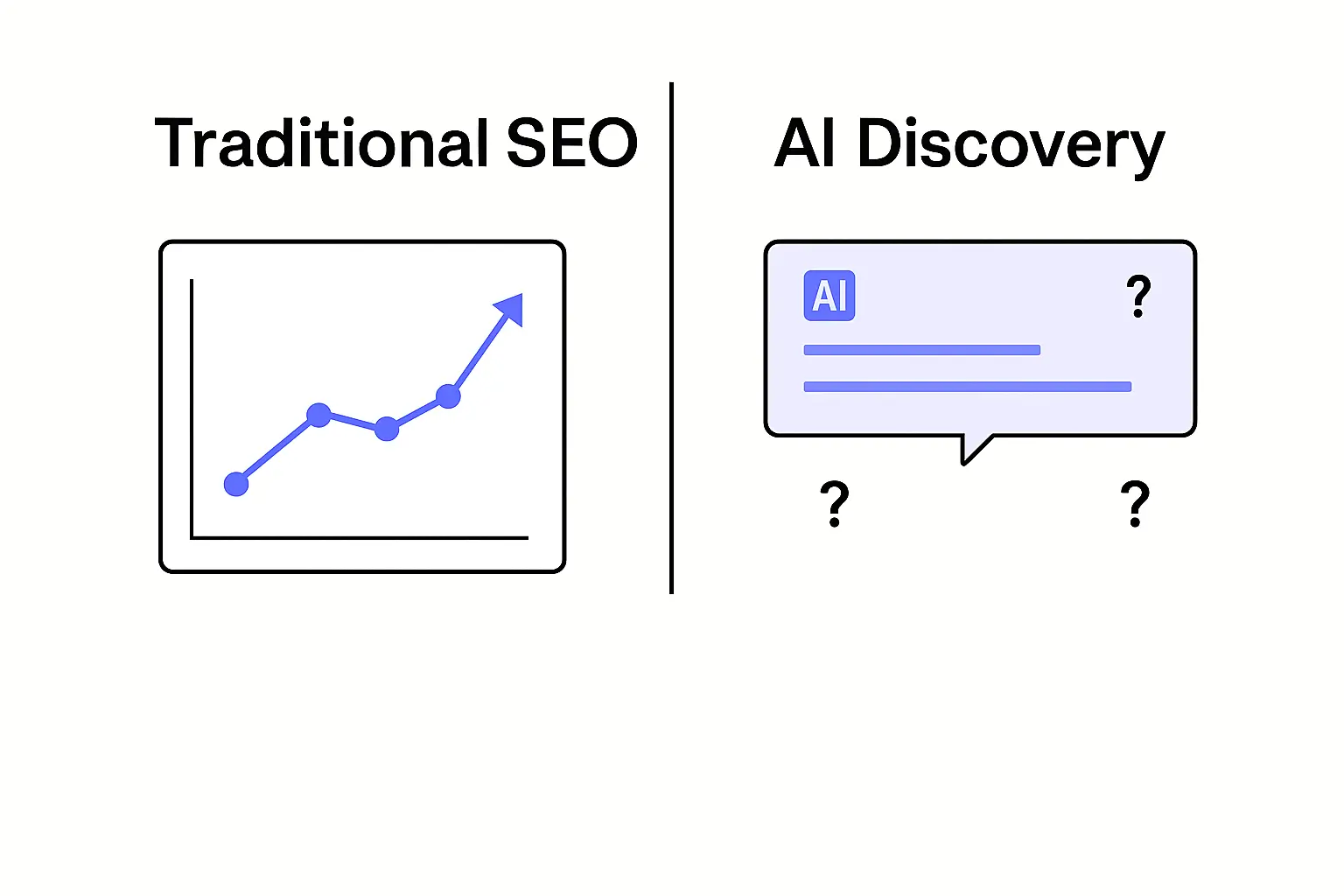
By the time we started working together, the client wasn’t just dealing with traffic loss or stiffer competition—they were questioning the entire SEO strategy.
Like many in the industry, they were hearing the same noise:
The internal debate wasn’t about small tactics. It was deeper:
Should we still be investing in SEO—or should we shift our focus to AI channels like ChatGPT, Perplexity, or other LLMs?
This hesitation created confusion. Despite SEO driving nearly 80% of their traffic, the future felt uncertain. Should they double down on what had worked—or pivot to what was trending?
What the client needed at that point wasn’t just execution—it was clarity.
They needed to understand:
These were the questions we helped them confront head-on.
The first step wasn’t jumping into execution. It was bringing clarity.
The client had a very real concern—is SEO still worth investing in if AI chatbots are taking over?
To be honest, we understood the fear. As SEO practitioners, we were asking the same questions ourselves. But we were also staying close to the data—tracking the trends, reading industry reports, running our own analysis.
In fact, a couple of months after we began working together, we published a study comparing 24 months of traffic between the top 10 AI chatbots and top 10 search engines, using Semrush data.
Between April 2024 and March 2025, chatbots grew from 30.5B to 55.2B visits—an 80.92% increase. In contrast, search engines saw a slight drop from 1,872.5B to 1,863.0B, just 0.51%.
Even with rapid growth, chatbot traffic was only 1/34th the size of search engine traffic.
It wasn’t a replacement—it was an additional layer.
You can read the full study here, but the key takeaway was clear.
This echoed what we had told the client at the time:
Search isn’t dying—it’s evolving.
And most people still prefer search engines for tools, features, and transactional queries.
For a business like theirs—focused on AI tools and transactional intent—the opportunity in SEO was still huge. Yes, informational content may be more vulnerable to AI summarization. But tool-based queries? People still search. Still click. Still convert.
So we laid out a clear, dual-track strategy:
→ Keep SEO as the foundation
→ Add GEO to prepare for the AI future
From there, we got to work—with three core initiatives:
Next, we’ll break each of those down.
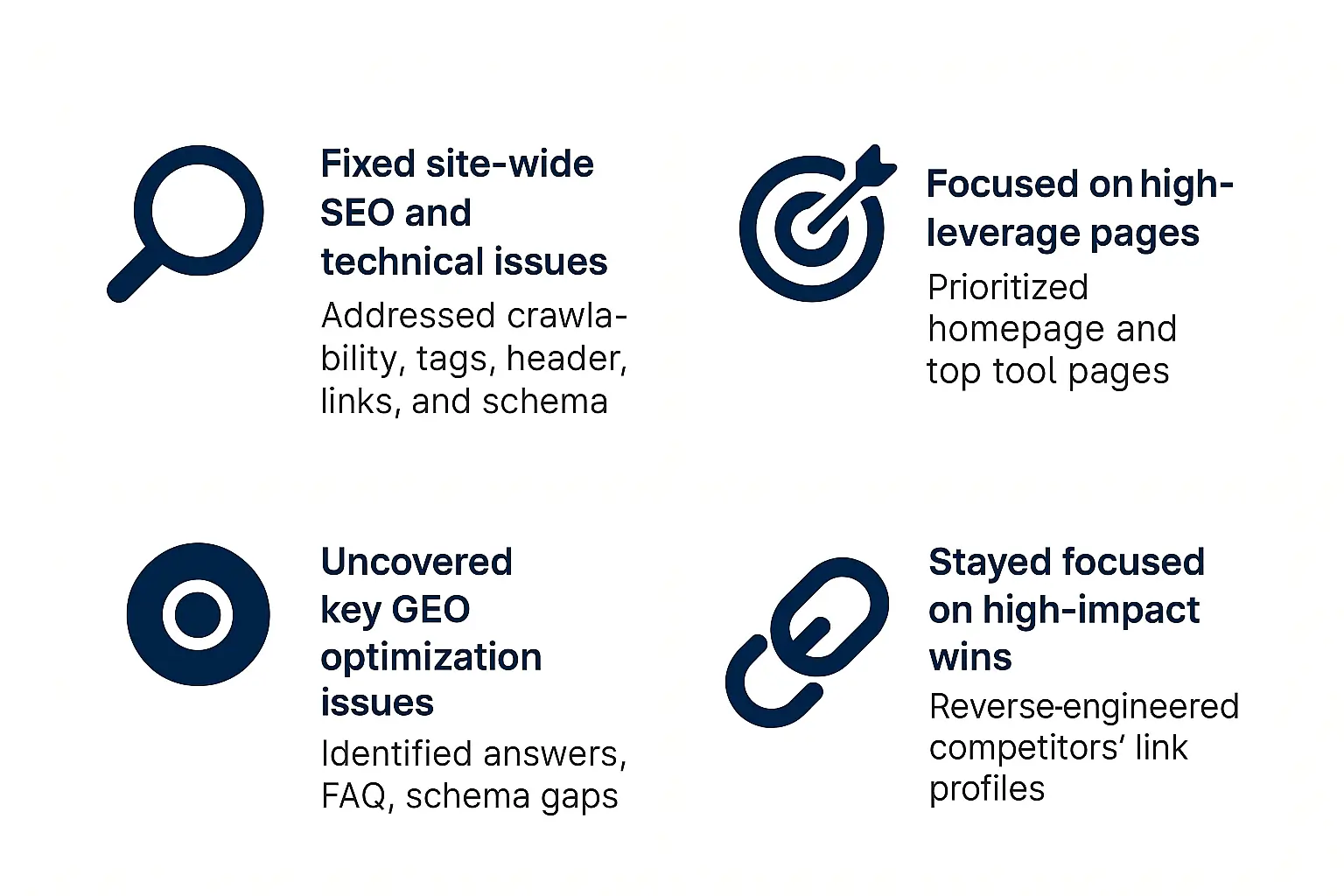
Before doing anything else, we ran a full-scale audit to understand where the client stood—and what was holding them back.
We used Ahrefs, Screaming Frog, and manual review to analyze everything from on-page SEO structure to technical performance. We also looked beyond the site itself—benchmarking against top competitors for major keywords to spot missed opportunities and ranking gaps.
Importantly, we included GEO-readiness in the audit—evaluating how well the site was structured for visibility in large language models like ChatGPT and Perplexity.
Here’s what we found—and how we prioritized our actions:
The goal: strengthen authority at both domain and page level by earning relevant, high-quality backlinks from sources already trusted by Google—and by their competitors.
We’ll cover how we executed that strategy in the next section: Link Building for Authority and Relevance.
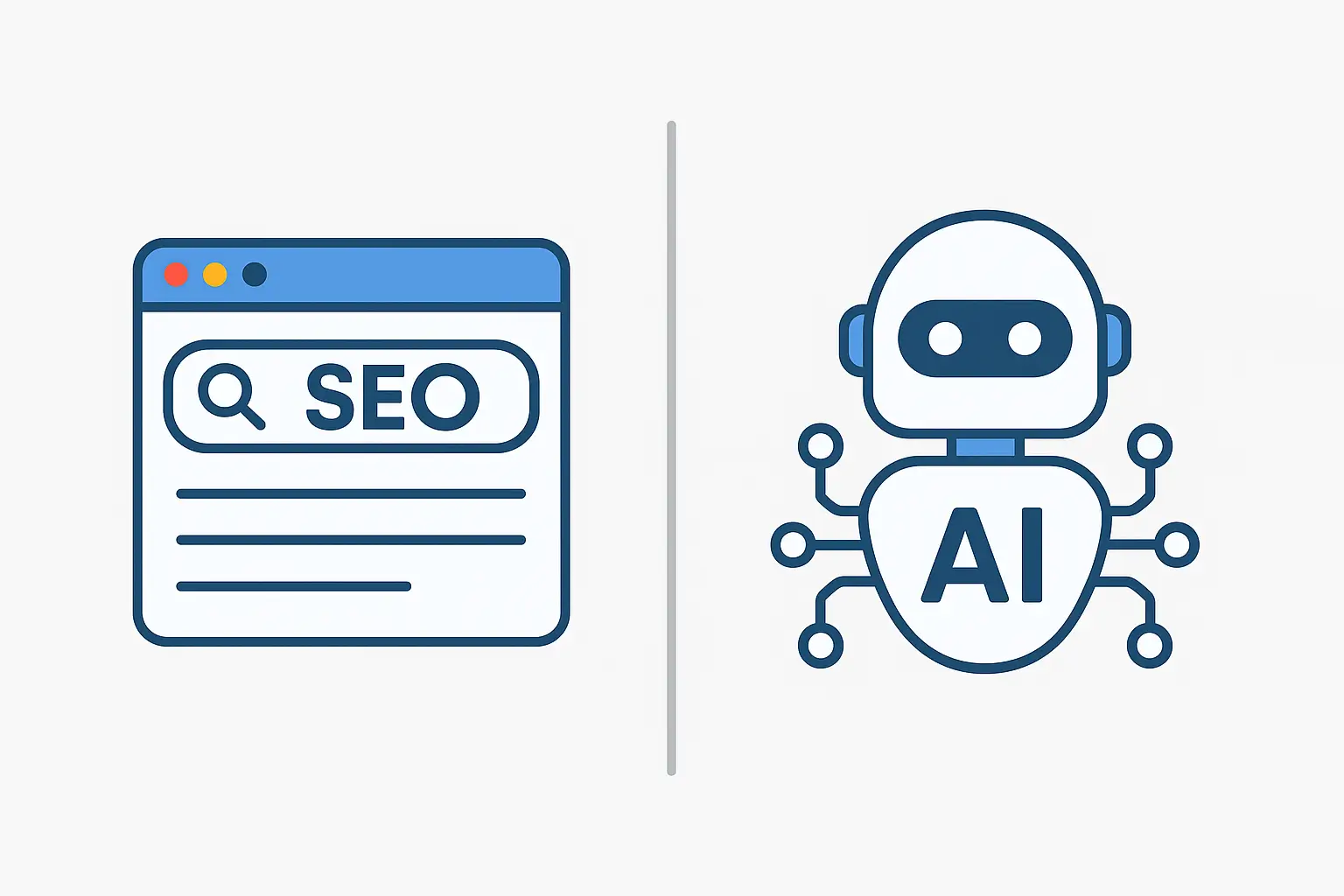
With the audit complete, our next move was to implement the technical fixes and prepare the site for both search engines and large language models (LLMs).
We addressed key issues that were limiting crawlability, indexation, and overall performance:
These changes laid the foundation for more stable rankings and better indexing.
We also optimized the site for Generative Engine Optimization (GEO)—a key step for visibility in AI platforms like ChatGPT, Perplexity, and Claude.
GEO wasn’t a replacement for SEO—it was a complementary layer designed to make the content understandable, extractable, and citable by AI engines.
With the technical groundwork in place, it was time to increase the site’s authority—starting with strategic link acquisition.
We knew from the start: in a niche this competitive, link volume alone wouldn’t move the needle. Our strategy focused on three things — quality, relevance, and matching (or beating) the backlink profile of competitors targeting the same keywords.
We set clear criteria from day one:
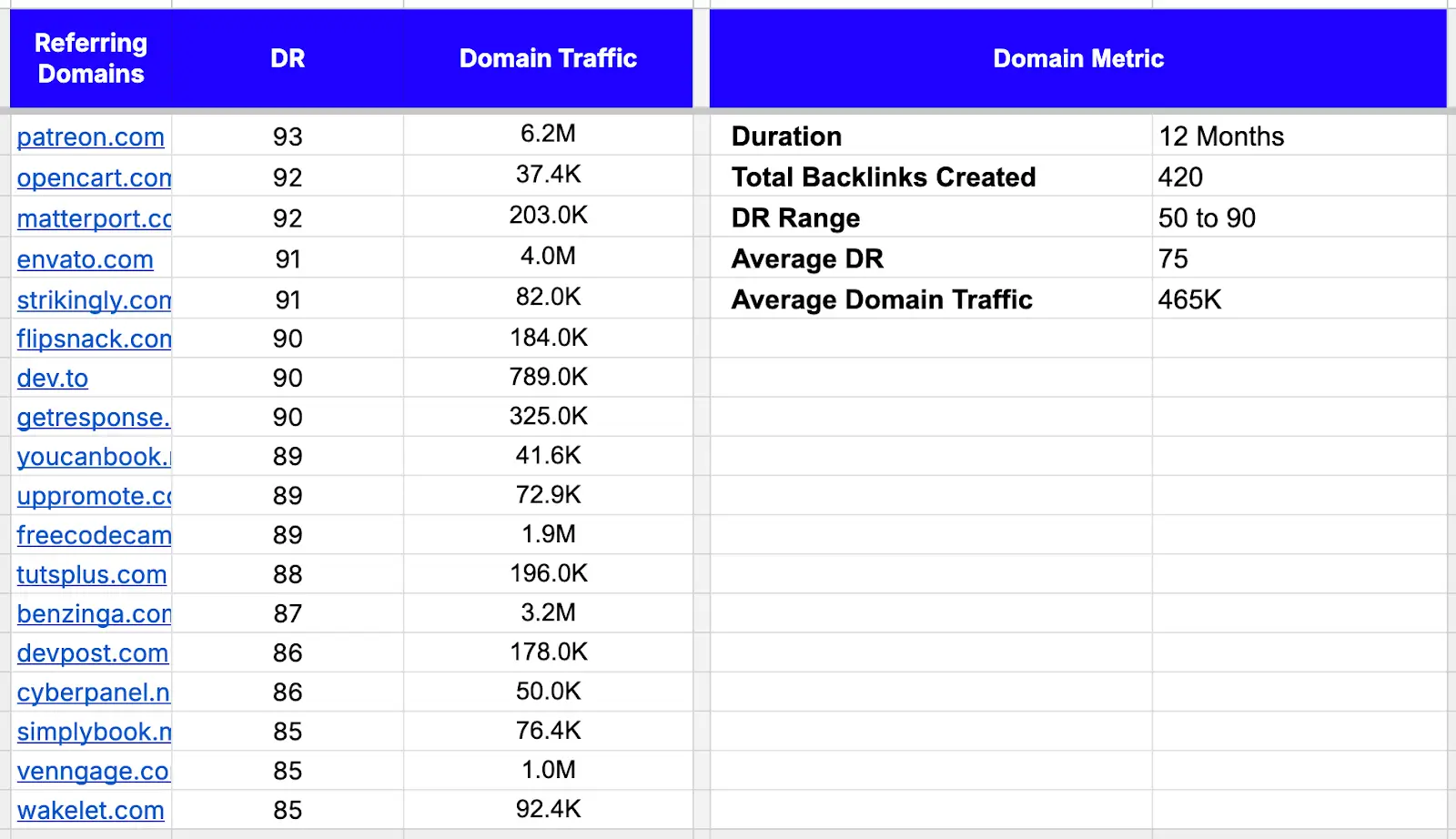
With these benchmarks in place, we rolled out a sustained link-building effort that stretched over 12 months. On average, we created around 35 targeted backlinks per month — aligned with the competitive landscape and seasonality.
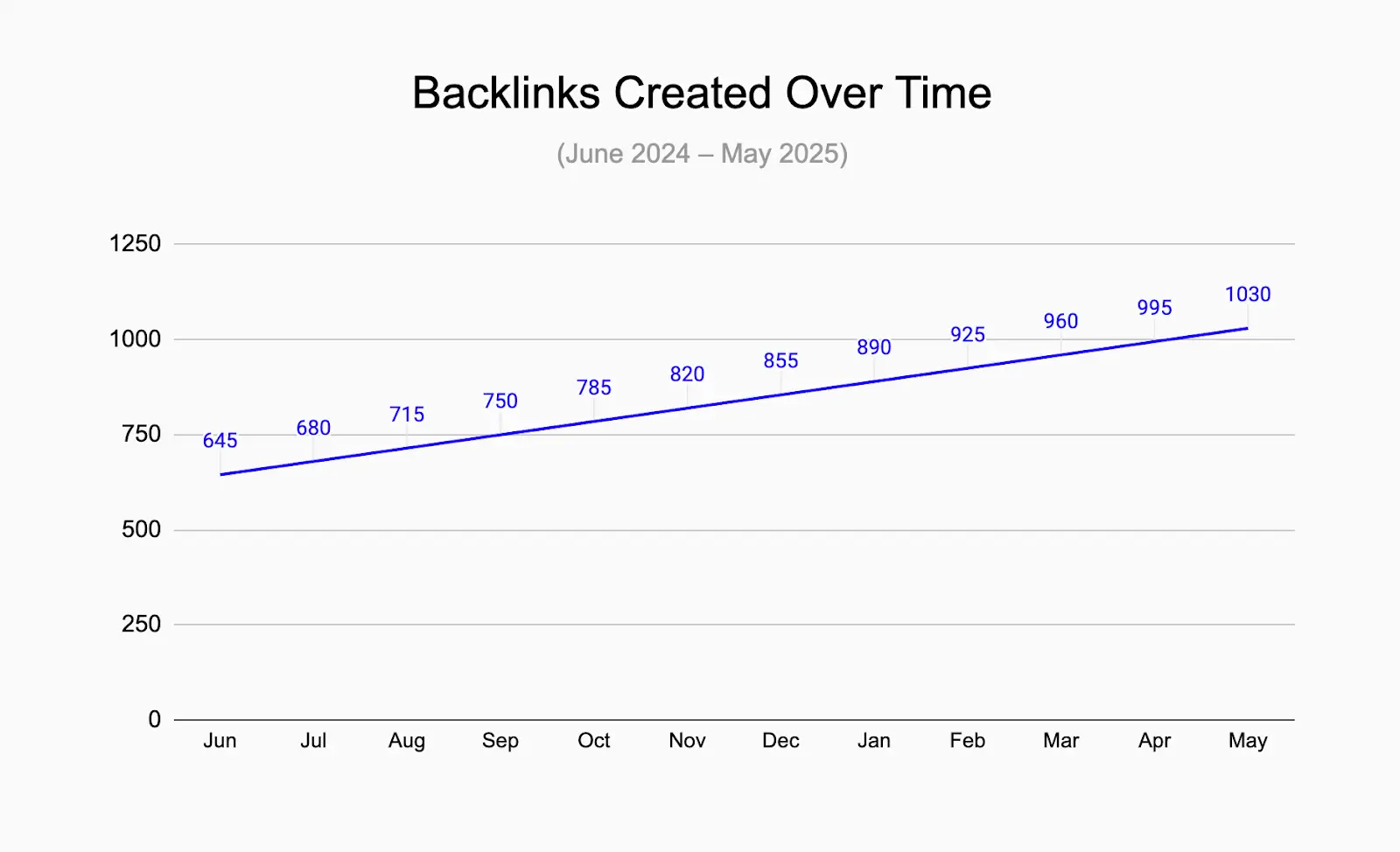
As the links compounded, we started seeing meaningful results in domain authority and keyword visibility. This wasn’t just about building backlinks — it was about reinforcing topical authority, domain trust, and search presence.
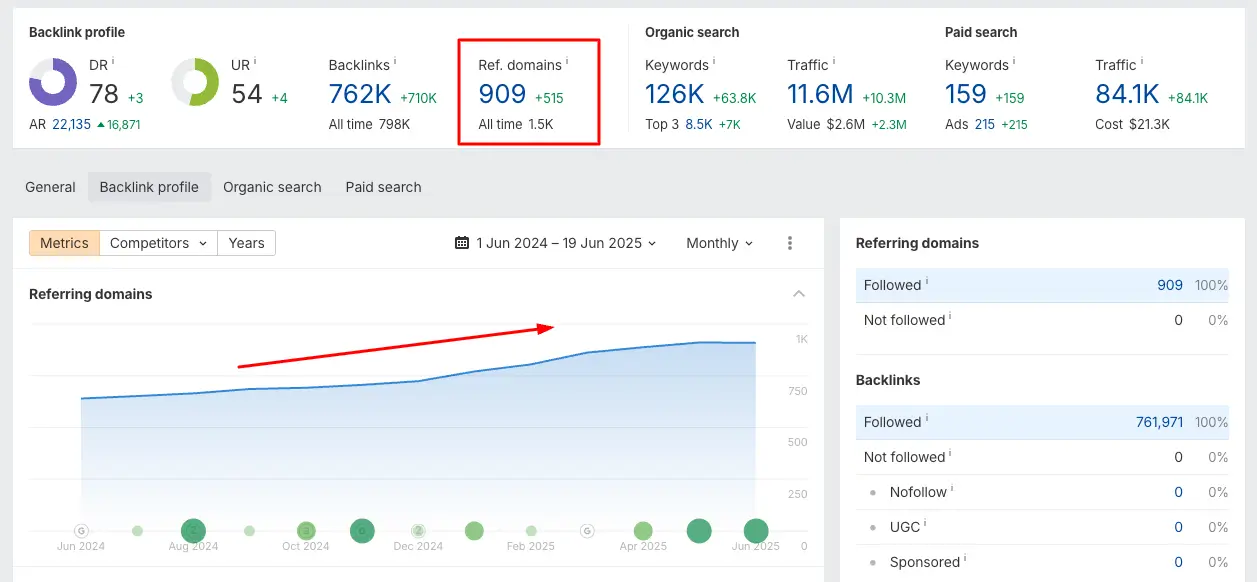
Instead of chasing vanity traffic, we focused on sustainable, high-impact growth across both traditional search engines and emerging generative platforms.
Here’s what changed after implementing our strategy:
We optimized the technical foundation, elevated authority through targeted backlinks, and focused on high-leverage pages.
→ Monthly SEO traffic grew from 10.5M to 18.5M — a 76% YoY increase
→ Highest gains came from pages we optimized for speed, structure, and relevance
→ Rankings improved across competitive keywords where competitors previously dominated
The following year-over-year chart shows the difference in organic search traffic before and after our partnership:
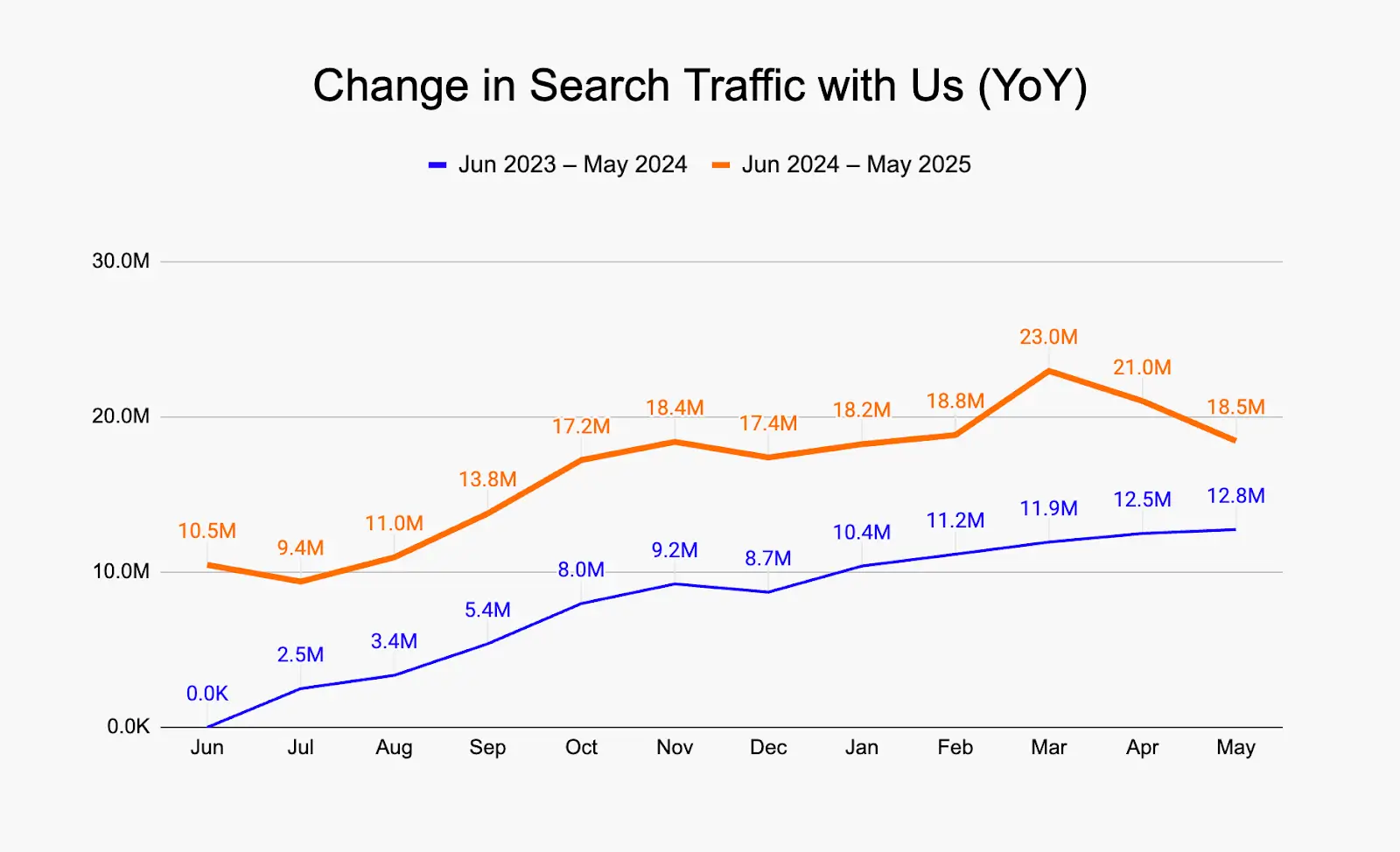
While chatbot traffic still makes up a smaller slice of the pie, the growth trajectory is exponential. We ensured the site was discoverable and accessible within LLMs — and the traffic followed.
→ Monthly chatbot traffic rose from 2K to 40K sessions — a 1900% growth
→ Key visibility came from platforms like ChatGPT, Perplexity, Claude, and Gemini
→ Structured answers, clean metadata, and strong brand associations helped win inclusion
The dashboard below captures traffic metrics from AI chatbots, broken down by session count, key engagement rates, and LLM referrers.
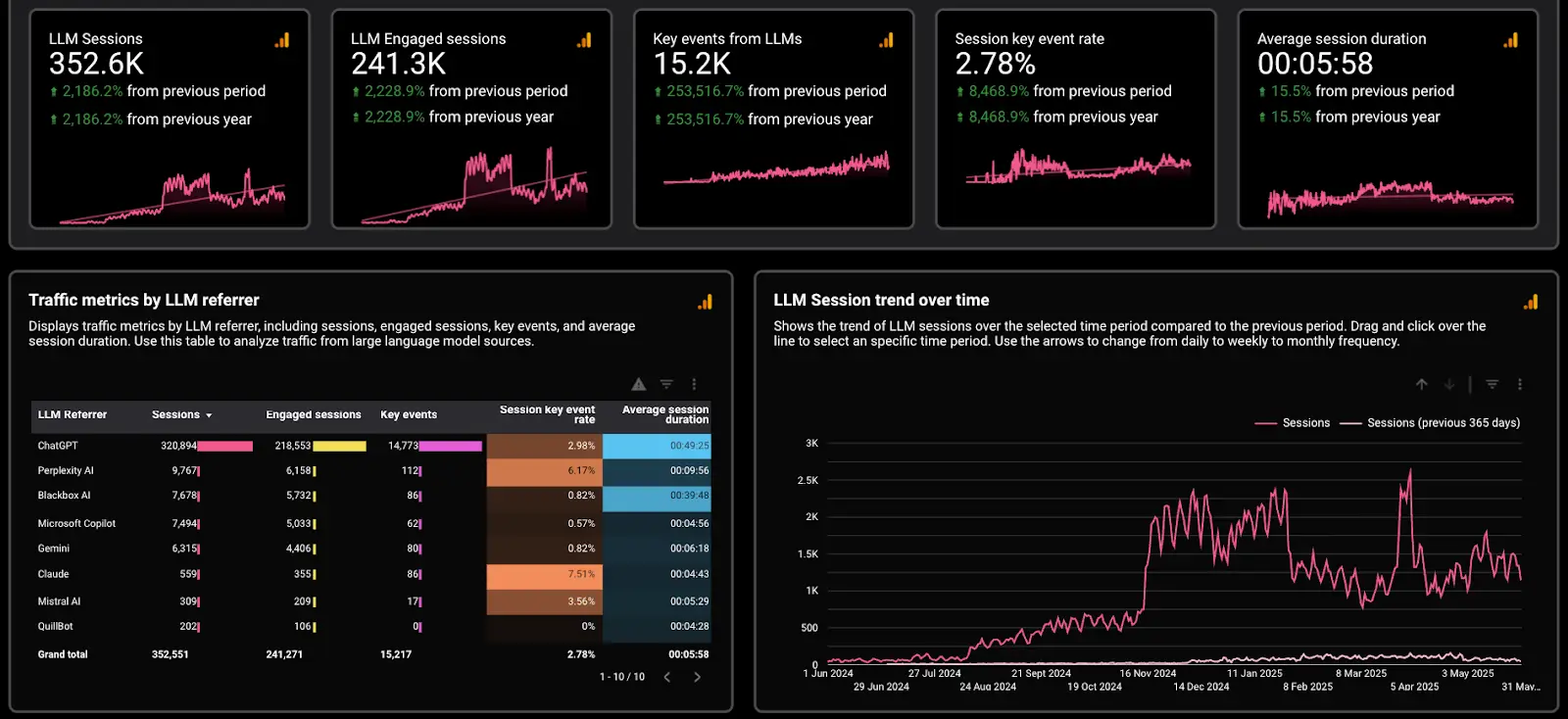
In just 12 months of collaboration, the results were clear: SEO remains an essential traffic engine, even in the face of AI disruption.
By focusing on technical SEO, GEO readiness, and high-quality backlinks, we were able to:
What’s most important: SEO isn’t going anywhere—it’s evolving. Businesses that adapt to both search engines and AI-driven discovery will thrive in this changing landscape.
The client’s success story demonstrates how a dual-focus strategy—optimizing for SEO while preparing for LLMs—creates long-term, cross-channel growth.
See how our clients achieve explosive growth with our SEO and link-building strategies.
Cost Savings
Premium Links
Book a call to discuss how we can help you dominate competitive and high search volume keywords while keeping the cost low.
They are solid people who run a quality service and always deliver. Highly dependable and honest.

Founder, DeepAI